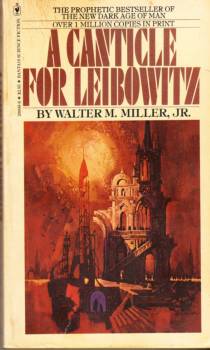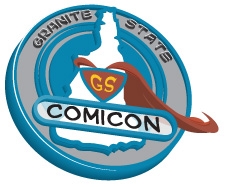
In the process of writing my last article my mind wandered, as it is wont to do, down a myriad of paths suggested by what I was writing. One of those paths was the cyclical nature of end-of-world prophesies, which in turn reminded me of a classic genre piece that revolves around the cyclical nature of human society: A Canticle for Leibowitz by Walter M. Miller, Jr. This novel was the only one he wrote and published during his lifetime, yet its inclusion in the NPR Top 100 Science-Fiction and Fantasy survey at number 35 shows how well received it was by those who read it. Because Miller wrote just this one book, however, there are probably many sci-fi aficionados who have never heard of the book. As one who enjoyed the book tremendously I thought I’d bring it to the attention of those who might not have read it.
In this first article I’ll provide a quick synopsis of the book to entice you to read it and to provide some background for a second article in which I’ll briefly discuss how Miller addressed two themes in the book that are relevant to today’s world: the give and take between church and state, and the dynamic tension between science and religion. I’ll also cover how I see them being cyclical in Miller’s eyes00.
The book is divided into three sections: Fiat Homo, Fiat Lux, and Fiat Voluntas Tua (pulling on my HS Latin, Let There be Man, Let There be Light, and idiomatically, Thy Will be Done, respectively). Fiat Homo takes place six centuries or so after a nuclear war (called the Diluvium Ignis, or Flame Deluge, in the book), with mutants of various sorts roaming the countryside and the world still trying to recover from the orgy of violence against science and learning that the war spawned. Somewhere in the American Southwest (my best guess is somewhere near Gallup, NM), at the isolated abbey dedicated to preserving knowledge from before the war, Brother Francis Gerard is on a Lenten fast for novitiates. He spots a mysterious traveler, who inadvertently leads him to an underground fallout shelter that harbors relics from the abbey’s patron, Isaac Edward Leibowitz. These relics are eventually presented to New Rome (but not without considerable torment of Brother Francis by the Abbot in the meantime), which results in Leibowitz being beatified as a Saint. Brother Francis represents the Abbey at the beatification in New Rome, but meets with a mishap on the way back, ending this first section.
In Fiat Lux time has vaulted forward another six centuries or so, and the Albertian Order of St. Leibowitz is still busy preserving and trying to interpret the knowledge they’d saved from before the war, and science is making a comeback–as are competing “kingdoms” and rumors of war. The Einstein of the age, Thon Taddeo Pfardentrott, attempts to get the abbey to send him some of their historical technical texts, but the monks refuse. The Thon and his party finally come to the abbey, where he is amazed, (and slightly miffed to learn that all his discoveries had been discovered before), by all he finds in the Leibowitz Memorabilia. While he’s there, battles rage among the different kingdoms that have sprung up across the old US, sparked by dealing and double-dealing by the Prince of Texarkana, who is the Thon’s cousin. There is considerable give and take between the monks and the Thon over what’s contained in the Memorabilia (as well as the technical achievement of one of the monks–an Edison to the Thon’s Einstein) and they part on adversarial terms, reflecting in microcosm the battle between Church and State going on around them.
The next six hundred years or so reflect the ascension of science over faith, and lead to the last section in the book, Fiat Voluntas Tua. The world is a technological one and, with the exception of interstellar travel, one not easily distinguishable from our current world or, for that matter, from the world that resulted in the Flame Deluge. The Monastic orders have persevered and the Albertian Order of St Leibowitz still sits in its abbey in the southwest, still responsible for the Memorabilia. It also has become a repository of monks with a variety of space-related skills and experience, including starship operations–an unstated and not publicly acknowledged hedge against the possibility of another societal meltdown, with a plan (Quo peregrinatur) to move the order and the Memorabilia to one of the space colonies should nuclear war once again break out. As events unfold leading to that meltdown, the Church finds itself with little constructive it can do to prevent it from happening other than initiating the Quo peregrinatur. In the meantime, the Abbot finds himself in conflict with the State over euthanasia for severely radiation-poisoned people. When the breakdown does occur–moving from an initial detonation of a couple of nuclear devices to a full out nuclear exchange–the selected members of the Order manage to leave the planet just in time, once again repeating their prime purpose of saving and perpetuating knowledge.
You’ve probably noted the significant number of Latin phrases in the article, and there are many more in the book; Miller felt they more accurately reflected the Catholic Church (he wrote the book before the Vatican II Council allowed contemporary languages to be used in Mass rather than Latin). A decent place to find translations for all these phrases, if you’re so inclined, is here.
This summary is minimalist, as I don’t want to give away too much of the story–Miller’s writing and characterization are so deep and rich that the story is far better told in his words. It’s more to whet your appetite, and provide background for my observations about what Miller had to say about science vs religion and Church vs State in my next article, coming soon.






Comments are closed.